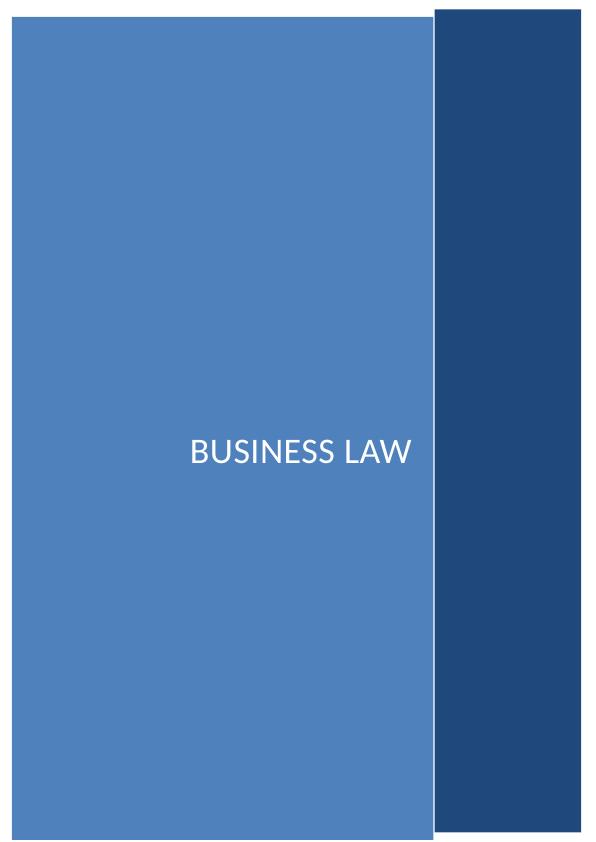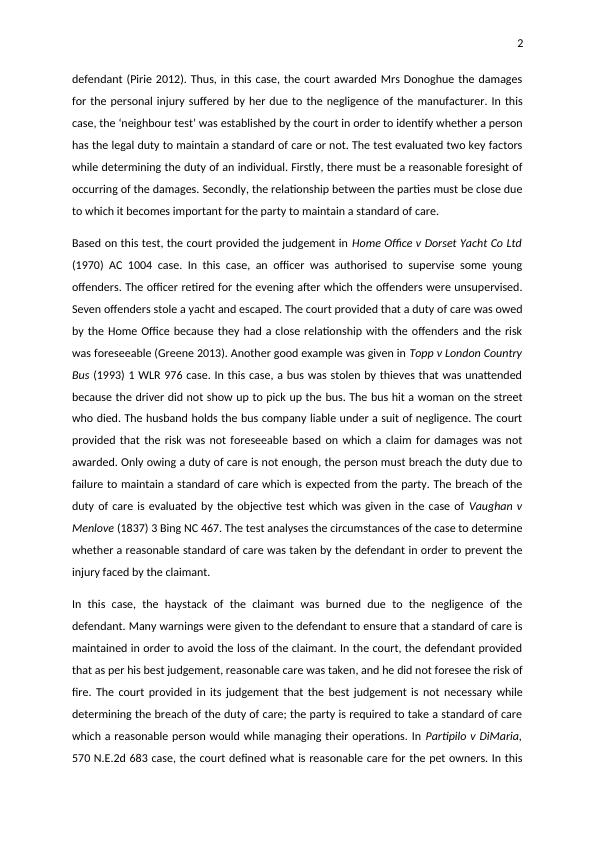Negligence and Liability in the Case of Susan and Cliff/Mary
Added on 2023-06-05
7 Pages2250 Words389 Views
BUSINESS LAW

1
QUESTION 1
ISSUE
The issue is whether Susan is liable for the financial and personal injury faced by Cliff and
Mary under the suit of negligence and whether the compensation can be demanded by Cliff
and Mary from Susan?
RULE
Negligence is referred to the civil wrong in which a person can be held liable for not taking
reasonable measures which resulted in causing damages to another party. The person who
did not take appropriate care to avoid causing damages to another party which resulted in
causing damages to another person, then a suit for negligence can be filed against such
person. Under the suit for negligence, the person will be held liable to repay the damages
which are faced by a party due to his/her negligence. It is important that the individual who
has the legal duty to maintain a standard of care should ensure that an injury is not caused
to another party due to the failure of maintaining the appropriate standard of care (Stickley
2016). In order to file a suit for negligence, it is significant that the person must owe a duty
to maintain a standard of care. In case no duty is owed by the party, then it is not possible
for the plaintiff to recover damages from the actions of the defendant. Donoghue v
Stevenson (1932) AC 562 is a significant case which determines a suit for negligence to
evaluate whether a person will be held liable or not. Mrs Donoghue went to a café and
ordered a ginger beer which was given to her in an opaque bottle. Due to the negligence of
the manufacturer, the remains of a dead snail were present in the bottle.
Mrs Donoghue became ill and suffered a personal injury after drinking the ginger beer. A
suit for negligence was filed against the manufacturer due to a breach of the duty of care. It
was held by the court that in order to establish a suit for negligence, it is important that the
party must owe a duty. Secondly, such duty must be breached due to the failure of the party
to maintain a standard of care which is expected of him. The injury faced by the party must
be caused directly due to the negligent actions of the defendant. The injury must not be too
remote or unforeseeable or else the suit for negligence cannot be filed against the
QUESTION 1
ISSUE
The issue is whether Susan is liable for the financial and personal injury faced by Cliff and
Mary under the suit of negligence and whether the compensation can be demanded by Cliff
and Mary from Susan?
RULE
Negligence is referred to the civil wrong in which a person can be held liable for not taking
reasonable measures which resulted in causing damages to another party. The person who
did not take appropriate care to avoid causing damages to another party which resulted in
causing damages to another person, then a suit for negligence can be filed against such
person. Under the suit for negligence, the person will be held liable to repay the damages
which are faced by a party due to his/her negligence. It is important that the individual who
has the legal duty to maintain a standard of care should ensure that an injury is not caused
to another party due to the failure of maintaining the appropriate standard of care (Stickley
2016). In order to file a suit for negligence, it is significant that the person must owe a duty
to maintain a standard of care. In case no duty is owed by the party, then it is not possible
for the plaintiff to recover damages from the actions of the defendant. Donoghue v
Stevenson (1932) AC 562 is a significant case which determines a suit for negligence to
evaluate whether a person will be held liable or not. Mrs Donoghue went to a café and
ordered a ginger beer which was given to her in an opaque bottle. Due to the negligence of
the manufacturer, the remains of a dead snail were present in the bottle.
Mrs Donoghue became ill and suffered a personal injury after drinking the ginger beer. A
suit for negligence was filed against the manufacturer due to a breach of the duty of care. It
was held by the court that in order to establish a suit for negligence, it is important that the
party must owe a duty. Secondly, such duty must be breached due to the failure of the party
to maintain a standard of care which is expected of him. The injury faced by the party must
be caused directly due to the negligent actions of the defendant. The injury must not be too
remote or unforeseeable or else the suit for negligence cannot be filed against the

2
defendant (Pirie 2012). Thus, in this case, the court awarded Mrs Donoghue the damages
for the personal injury suffered by her due to the negligence of the manufacturer. In this
case, the ‘neighbour test’ was established by the court in order to identify whether a person
has the legal duty to maintain a standard of care or not. The test evaluated two key factors
while determining the duty of an individual. Firstly, there must be a reasonable foresight of
occurring of the damages. Secondly, the relationship between the parties must be close due
to which it becomes important for the party to maintain a standard of care.
Based on this test, the court provided the judgement in Home Office v Dorset Yacht Co Ltd
(1970) AC 1004 case. In this case, an officer was authorised to supervise some young
offenders. The officer retired for the evening after which the offenders were unsupervised.
Seven offenders stole a yacht and escaped. The court provided that a duty of care was owed
by the Home Office because they had a close relationship with the offenders and the risk
was foreseeable (Greene 2013). Another good example was given in Topp v London Country
Bus (1993) 1 WLR 976 case. In this case, a bus was stolen by thieves that was unattended
because the driver did not show up to pick up the bus. The bus hit a woman on the street
who died. The husband holds the bus company liable under a suit of negligence. The court
provided that the risk was not foreseeable based on which a claim for damages was not
awarded. Only owing a duty of care is not enough, the person must breach the duty due to
failure to maintain a standard of care which is expected from the party. The breach of the
duty of care is evaluated by the objective test which was given in the case of Vaughan v
Menlove (1837) 3 Bing NC 467. The test analyses the circumstances of the case to determine
whether a reasonable standard of care was taken by the defendant in order to prevent the
injury faced by the claimant.
In this case, the haystack of the claimant was burned due to the negligence of the
defendant. Many warnings were given to the defendant to ensure that a standard of care is
maintained in order to avoid the loss of the claimant. In the court, the defendant provided
that as per his best judgement, reasonable care was taken, and he did not foresee the risk of
fire. The court provided in its judgement that the best judgement is not necessary while
determining the breach of the duty of care; the party is required to take a standard of care
which a reasonable person would while managing their operations. In Partipilo v DiMaria,
570 N.E.2d 683 case, the court defined what is reasonable care for the pet owners. In this
defendant (Pirie 2012). Thus, in this case, the court awarded Mrs Donoghue the damages
for the personal injury suffered by her due to the negligence of the manufacturer. In this
case, the ‘neighbour test’ was established by the court in order to identify whether a person
has the legal duty to maintain a standard of care or not. The test evaluated two key factors
while determining the duty of an individual. Firstly, there must be a reasonable foresight of
occurring of the damages. Secondly, the relationship between the parties must be close due
to which it becomes important for the party to maintain a standard of care.
Based on this test, the court provided the judgement in Home Office v Dorset Yacht Co Ltd
(1970) AC 1004 case. In this case, an officer was authorised to supervise some young
offenders. The officer retired for the evening after which the offenders were unsupervised.
Seven offenders stole a yacht and escaped. The court provided that a duty of care was owed
by the Home Office because they had a close relationship with the offenders and the risk
was foreseeable (Greene 2013). Another good example was given in Topp v London Country
Bus (1993) 1 WLR 976 case. In this case, a bus was stolen by thieves that was unattended
because the driver did not show up to pick up the bus. The bus hit a woman on the street
who died. The husband holds the bus company liable under a suit of negligence. The court
provided that the risk was not foreseeable based on which a claim for damages was not
awarded. Only owing a duty of care is not enough, the person must breach the duty due to
failure to maintain a standard of care which is expected from the party. The breach of the
duty of care is evaluated by the objective test which was given in the case of Vaughan v
Menlove (1837) 3 Bing NC 467. The test analyses the circumstances of the case to determine
whether a reasonable standard of care was taken by the defendant in order to prevent the
injury faced by the claimant.
In this case, the haystack of the claimant was burned due to the negligence of the
defendant. Many warnings were given to the defendant to ensure that a standard of care is
maintained in order to avoid the loss of the claimant. In the court, the defendant provided
that as per his best judgement, reasonable care was taken, and he did not foresee the risk of
fire. The court provided in its judgement that the best judgement is not necessary while
determining the breach of the duty of care; the party is required to take a standard of care
which a reasonable person would while managing their operations. In Partipilo v DiMaria,
570 N.E.2d 683 case, the court defined what is reasonable care for the pet owners. In this

End of preview
Want to access all the pages? Upload your documents or become a member.
Related Documents
Can Cliff and Mary recover their damages by filing a suit of negligence against Susan?lg...
|6
|2283
|397
Liability for Negligence in Case of Pet Ownerslg...
|8
|2445
|475
Can Cliff and Mary sue Susan for negligence?lg...
|7
|2387
|124
Analysis of Negligence Liability in the Case of Cliff and Mary vs Susanlg...
|7
|2264
|195
Negligence Tort: Elements and Defenceslg...
|7
|2349
|267
Suit for Negligence: Elements, Defences and Applicationlg...
|6
|2401
|444
